It's hard to know where to begin to talk about the Neuros OSD. It's both a spectacularly fun device to use, and a difficult one to explain. It's the kind of gadget with a very high wow factor – you'll want to show it off to everyone who visits. This little gizmo, like a Treo, has so many features, it deserves much more than a single review.
However, Neuros' own Web site has a ton of information about the OSD, plus an entire community where you can interact with other OSD owners, firmware developers, and Neuros themselves, so if you buy one, you won't have to flail around helplessly by yourself if you need answers.
What is it?
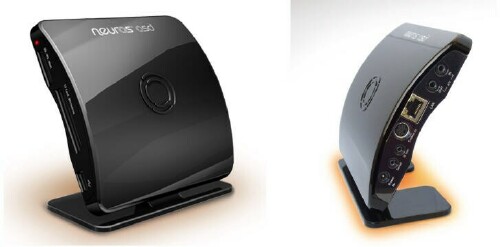
The OSD is a small, curvy, shiny black plastic widget (about the size of a man's wallet) that's the next generation successor to the still-available Neuros Recorder 2 Plus ("NR2P"), a wildly popular product I reviewed in late 2006.
I think comparisons between a mfr's old and new products are both necessary and inevitable, so I'll spend some time explaining the differences between the older Neuros Recorder 2 Plus and the OSD.
I've been using the NR2P almost daily, to record and save TV shows and movies onto SD cards as MPEG-4 video files, the content served up by my digital cable box, then play them back on my TV directly from the NR2P, and copy the files from those cards onto my laptop's huge hard drive, (a two hour MPEG-4 being anywhere from about 400mb to twice or triple that size, depending on the recording quality setting).. and play them, both on the laptop, and on my Treos by scaling them down with Kinoma Producer 4 to make them more Treo-friendly, or, more recently, simply streaming them directly to the Treo off my hard drive with the revolutionary new Winamp Remote Beta, which is a somewhat re-vamped version of Orb, both of which turn your personal computer into your own private media server.
Confused yet? If you're getting lost in this flurry of products and jargon, let me try to quickly simplify things.
In a nutshell..
The NR2P and the new OSD are tiny media recorders / players that make an analog connection to and record from devices you already own (digital cable box, DVR, VCR, DVD player, and so on).. you can take those digital recordings, which are DRM-free, and play them back using the Neuros devices themselves, or transfer them to a computer and store them, play them, Edit or scale them, and play them on your Treo or other hand-held. Because the Neuros boxes use an analog connection, if you can see it on your TV, you can record it, including copy-protected DVDs.
An aside – Neuros' DRM philosophy.
DRM and copy protection are high-priority subjects in the halls of Neuros' Chicago offices. Remember all those vinyl records you had and how easily you could record them to tape? By its very nature, vinyl had no copy protection. Many, including this writer (and Neuros) think today's consumer media shouldn't either.. so in that vein, I got this in an email from their Product Manager:
Hi Harv-
Neuros is taking a new approach to dealing with the DRM issue, I thought you might find it interesting. In response to the branded, proprietary DRM schemes like Microsoft's "plays for sure" and Apple's "FairPlay," Neuros has created an "Unlocked" Media trademark to promote the concept of open standard
DRM-Free files that can be stored and played anywhere. Click here to read about it.
We hope that other organizations (community and for profit) will adopt this mark for products that generate such files (or stores that sell such files), and create a grass roots movement (with your help) in support of unlocked files.
The NR2P's limitations – the OSD's solutions..
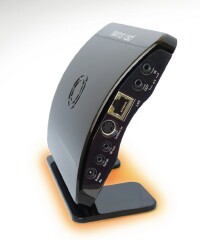
As cool as the NR2Plus was, it had a lot of limits. This was due to its Chinese-coded firmware and hardware. Although firmware upgrades to fix these things were promised, Neuros eventually decided to create an entirely new device instead – one with much better specs, and one over which they would have total control of the firmware. The OSD is NOT just a slightly re-vamped NR2 in new casework.. and it's actually been available to early adopters for some months.. developers, and those willing to put up with slightly flakey, constantly-changing Beta firmware. Now it's gone "Golden" and is on retail shelves everywhere, but it's still a work in progress; the firmware is still evolving and changing.
Before we open the OSD's box and examine what tumbles out, I think it's important to detail the important differences between the two devices. The $100.00 price difference reflects the OSD's more advanced hardware and capabilities. (See my NR2plus review for pictures of that device)..
NR2P
- individual recordings limited to 2 hours (actually 1:59:59) forced recordings of movies longer than that to end up as two files with a 30 second gap between them.
- can't pause during a recording like you can with a VCR.. (maybe you'd like to Edit out commercials on the fly.. no can do).
- onboard file Storage limited to a pair of SD cards (one in a CF adapter)
- six recording timers max.
- no way to name or rename files with the device itself
- fussiness about audio levels during recording phase often caused audio distortion in files.
- credit card-sized remote with unlabeled membrane buttons
- proprietary, closed operating system
OSD

- recordings limited to 4gb per file, regardless of time length
- two memory card slots PLUS a powered USB 2 jack! Connect a hard drive to the OSD and store massive amounts of files. Connect, record to, and even charge an iPod.
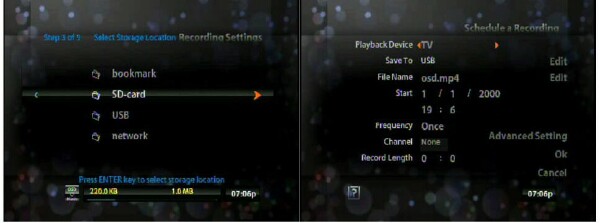
- unlimited recording timers
- new audio co-processor results in much cleaner distortion-free sound in your recordings.
- a "real" full-sized, programmable remote that controls the OSD AND your TV.
- MUCH more control over recording parameters such as resolution, Video Bitrate, Frame rate, Audio Format, and Audio Bitrate
- Open Source Linux OS – developer-friendly; create your own OSD GUI if you have the tools and the know-how.
- can create folders on connected Storage devices – easily organize your recordings, and move them from one folder or Storage device to another
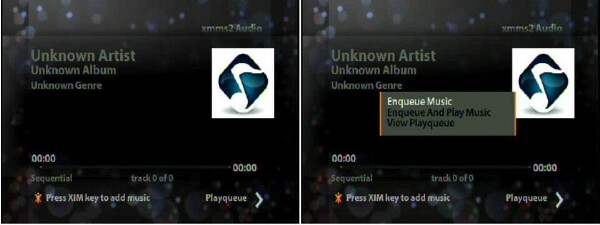
- queue up and play audio files and make / save playlists.
- name and re-name recordings before AND after you make them with an on-screen keyboard
- pause during a recording (Yay!)..
- 1x, 2x, 4x, 8x, and 16x playback both forward and reverse, and 30 sec. jump-ahead button on remote.
- programmable screensavers that kick in after a chosen period of time (just like your computer) to prevent TV screen "burn-in" of the OSD's on-screen GUI.
- Standard three-color cable analog input PLUS higher quality
S-Video input.
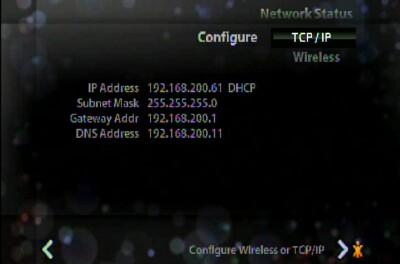
- Networkable! Built-in high-speed Ethernet port. Cable the OSD to your router and move files to and from it with no "sneakernetting" which also lets the OSD auto-upgrade its firmware upon each new release.
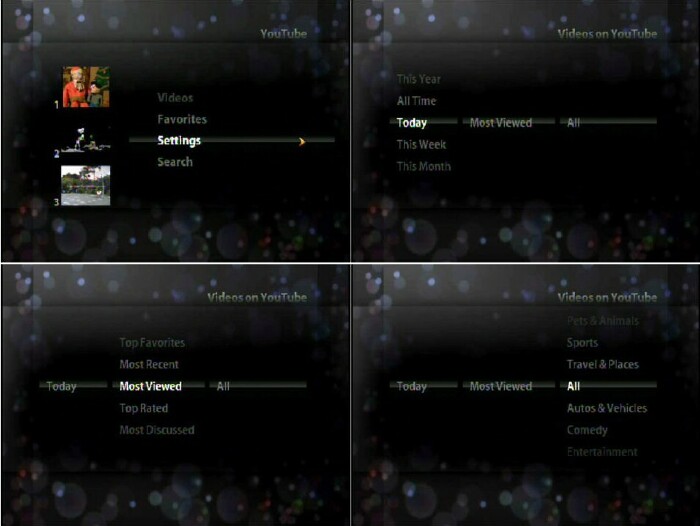
- search, browse, select, and view YouTube.com videos right on your TV
Here are a bunch of screen shots using the OSD to search YouTube, and play a video..
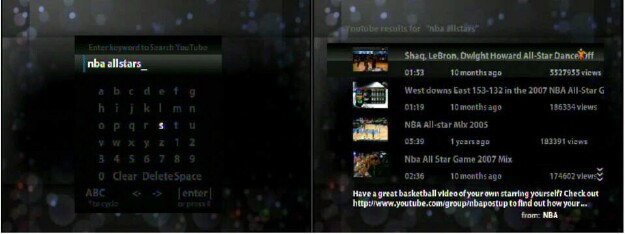

- Completely re-vamped, prettier, multi-level GUI with built-in help screens and a ton of new features.
There are many more differences between the two – the OSD is FAR more than just a Neuros Recorder "3".. and if you already own an NR2P and your brain is trained in its operation, like mine was, migrating to an OSD can be somewhat overwhelming as you learn its capabilities and differences. Neuros is trying to simultaneously give the OSD every feature people want, and keep it simple for non-tech types to use.
But once you've nailed its operation, you'll be well-rewarded by its vastly expanded capabilities, superior recordings (both video and audio), and myriad of new features.
The OSD is an uber-cool gadget. After playing with it for a few weeks, (with an 80gb hard drive attached to it) I think this little black wonder makes the home VCR obsolete, except as a playback device to use the OSD to turn your old VHS tapes into MPEG-4 files. With that hard drive attached to it, I can store over 150 high quality two hour movies on the OSD. You could connect a HUGE hard drive to it. And of course, it'll also play audio files and display digital image files.
Thanks to its open source OS, and frequent firmware updates, new features and GUI changes are constantly added, and (unlike a Treo) you can even DOWNgrade its firmware back to an earlier version if you want to.
Opening the box.
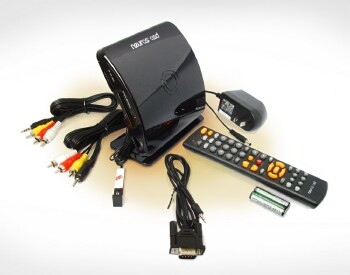
Neuros ships the OSD in a gorgeous retail box, jam-packed with almost all the stuff you'll need to get up and running quickly. Almost, because the only thing lacking in the package is Storage media. You'll have to supply your own memory cards and / or hard drive.
Lift the magnetic flap on box and you'll find:
- The Neuros OSD itself, swathed in peel-off protective plastic sheets
- a black plastic stand. Depending on where you put the OSD, you can lay it flat, like the NR2P, or dock it to this stand so it sits in an upright position
- the new remote control and its pair of AAA batteries. The remote is a huge improvement over the NR2P's, and its keys repeat when held down (thankyouverymuch!).
- an AC adapter
- two sets of red / yellow / white Analog cables, one for input from your source device(s), one for output to your TV, same as comes with the NR2P. (if you prefer to use the OSD's S-Video input jack, you'll have to supply your own S-Video cable).
- an Infrared "blaster" or "emitter" – using this is optional, but if you connect it to your OSD and position it near your digital cable box's IR receiver window, you'll be able to program the OSD to change
channels on your cable box for timed recordings. Otherwise, you can just use your cable or satellite box's built-in program grid to tell it to change channels when you want to schedule recordings.
- a Serial cable. Most consumers won't need this at all, but it's included for developers who want to build their own OSD firmware.
- an illustrated eight page fold-out Getting Started / Setup sheet
- a fold-out multi-page Remote Control Programming Guide. Like the NR2, the OSD has NO controls on its body at all. EVERY function is handled with the remote, but unlike its predecessor's little credit card remote, the OSD's full-size controller is not only labeled, but programmable – this sheet explains FOUR different ways you can program it to control your TV by either punching in the right three digit code for countless brands and models, or by using its different auto-search features. Once you feed the remote, or it finds the right IR code to power the TV on and off, that's it, you're done, and you should never have to look at this sheet again, unless you want to move the OSD to a different room and re-program the remote to control a different TV.
Setup
If you already own and have a Neuros Recorder 2 Plus installed, replacing it with the OSD is a piece of cake. You don't even need to take analog cables out of the OSD's box – you can simply unplug the NR2P from its existing input and output cables, and plug them right into the OSD. You WILL have to change power supplies, though, since the OSD's uses a slightly different jack, and of course, you'll need the new remote since the two products' remotes are device-specific.
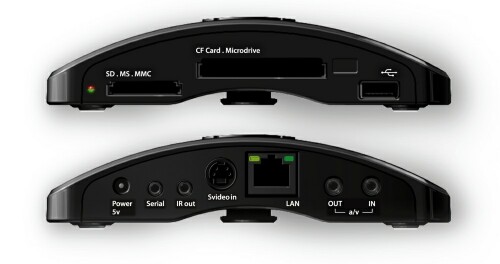
If you never owned the NR2P, then everything you'll need is in the OSD's box except Storage media. Get yourself a nice little high capacity compact USB 2 hard drive (which MUST be formatted as FAT32, NOT NTFS), and plug it into the OSD, or, you can use any regular SD memory cards you have, or shove a micro-drive into its CF card slot. For maximum Storage and minimum hassle, a compact hard drive's the way to go.
If you have a home router (and who doesn't), run an Ethernet cable from the OSD to it and network that puppy. This will not only make moving files to and from the OSD a lot easier, and by changing a setting, the OSD will auto-update its firmware as new versions are released, otherwise you'll have to download the 14mb firmware file, copy it to a card, and shove that card into the OSD. New firmware versions are released frequently. An update takes about ten minutes and someone at Neuros has a wacky sense of humor – the OSD displays a game of Pong while the firmware update's happening.
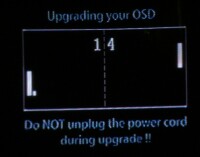
Networking the OSD also lets you search and watch YouTube videos on your TV, (this functionality is built into the firmware and ready to use).. and opens up possibilities for all kinds of future features.
If your router is nowhere near your OSD and TV, and you don't want to run a long cable around the room to connect the two, you could go with Ethernet Bridges, which transmit the same signal through your household wiring. More expensive than a length of cable, but a cleaner solution, visually and physically. But don't read this wrong.. you don't HAVE to network the OSD. It'll operate just fine without an Internet connection – you'll just be without a few features. The OSD is not WiFi-capable.
Next Page: It's always on >>